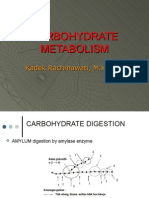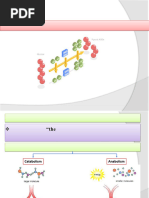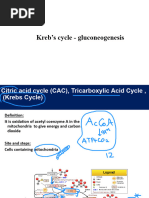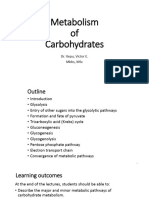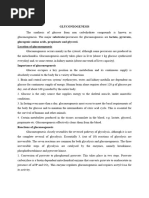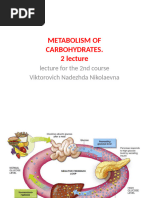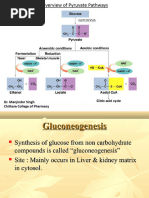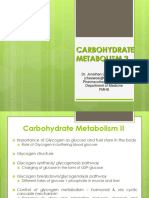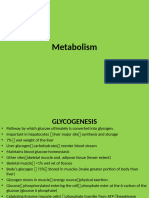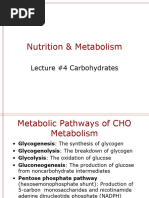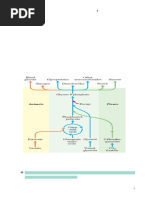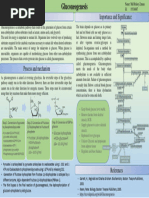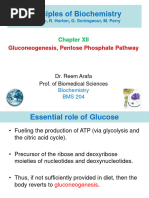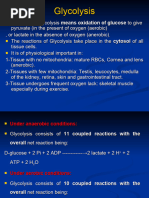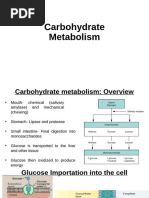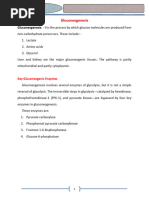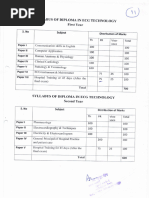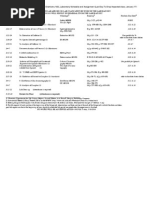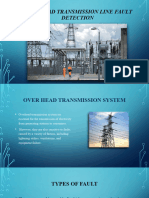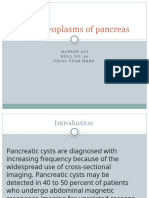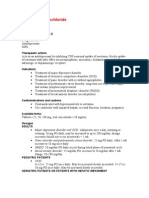Gluco Neo Genesis
Gluco Neo Genesis
Uploaded by
laraibarshad75Copyright:
Available Formats
Gluco Neo Genesis
Gluco Neo Genesis
Uploaded by
laraibarshad75Copyright
Available Formats
Share this document
Did you find this document useful?
Is this content inappropriate?
Copyright:
Available Formats
Gluco Neo Genesis
Gluco Neo Genesis
Uploaded by
laraibarshad75Copyright:
Available Formats
Gluconeogenesis- Steps,
regulation and significance
Dr. Adnan Riaz
Introduction
• Gluconeogenesis is the process of converting
noncarbohydrate precursors to glucose or
glycogen.
• Gluconeogenesis meets the needs of the body
for glucose when sufficient carbohydrate is not
available from the diet or glycogen reserves.
• A supply of glucose is necessary especially for
the nervous system and erythrocytes.
• Failure of gluconeogenesis is usually fatal.
Dr. Adnan Riaz Gluconeogenesis
Substrates of Gluconeogenesis
• The major substrates are the glucogenic amino
acids, lactate and glycerol.
• These noncarbohydrate precursors of glucose
are first converted into pyruvate or enter the
pathway at later intermediates such as
oxaloacetate and dihydroxyacetone phosphate.
• Liver and kidney are the major gluconeogenic
tissues.
Dr. Adnan Riaz Gluconeogenesis
•Glycolysis Step
Dr. Adnan Riaz Gluconeogenesis
5
Reactions of Gluconeogenesis
In gluconeogenesis, the following new steps
bypass these virtually irreversible reactions of
glycolysis:
1. First bypass (Formation of
Phosphoenolpyruvate from pyruvate)
2. Second bypass (Formation of Fructose 6-
phosphate from fructose 1,6-bisphosphate)
3. Third bypass (Formation of Glucose by
hydrolysis of glucose 6-phosphate)
Dr. Adnan Riaz Gluconeogenesis
6
First bypass (Formation of
Phosphoenolpyruvate from
pyruvate)
• Reversal of the reaction catalyzed by pyruvate
kinase in glycolysis involves two endothermic
reactions.
• Phosphoenolpyruvate is formed from pyruvate
by way of oxaloacetate through the action of
pyruvate carboxylase and
phosphoenolpyruvate carboxykinase.
• Pyruvate carboxylase is a mitochondrial
enzyme, whereas the other enzymes of
gluconeogenesis are cytoplasmic.
Dr. Adnan Riaz Gluconeogenesis
7
Reaction catalyzed by pyruvate
carboxylase
• Mitochondrial pyruvate carboxylase catalyzes
the carboxylation of pyruvate to oxaloacetate, an
ATP-requiring reaction in which the vitamin
biotin is the coenzyme.
• Biotin binds CO2 from bicarbonate as
carboxybiotin prior to the addition of the CO2 to
pyruvate.
Dr. Adnan Riaz Gluconeogenesis
Transportation of Oxaloacetate
• Oxaloacetate, the product of the pyruvate carboxylase
reaction, is reduced to malate inside the mitochondrion for
transport to the cytosol.
• The reduction is accomplished by an NADH-linked malate
dehydrogenase.
• When malate has been transported across the mitochondrial
membrane, it is reoxidized to oxaloacetate by an NAD+-linked
malate dehydrogenase in the cytosol.
Dr. Adnan Riaz Gluconeogenesis
Decarboxylation of oxaloacetate
A second enzyme, phosphoenolpyruvate carboxy
kinase, catalyzes the decarboxylation and
phosphorylation of oxaloacetate to
phosphoenolpyruvate using GTP as the
phosphate donor.
Dr. Adnan Riaz Gluconeogenesis
Second bypass (Formation of
Fructose 6-phosphate from fructose
1,6-bisphosphate)
• Fructose 1,6-bisphosphatase catalyzes this exergonic
hydrolysis.
• Its presence determines whether a tissue is capable of
synthesizing glucose (or glycogen) not only from
pyruvate, but also from triose phosphates.
• It is present in liver, kidney, and skeletal muscle, but is
probably absent from heart and smooth muscle.
• Like its glycolytic counterpart, it is an allosteric enzyme
that participates in the regulation of gluconeogenesis.
Dr. Adnan Riaz Gluconeogenesis
Dr. Adnan Riaz Gluconeogenesis
12
Third bypass (Formation of
Glucose by hydrolysis of glucose
6-phosphate)
• The fructose 6-phosphate generated by fructose
1,6-bisphosphatase is readily converted into
glucose 6-phosphate.
• In most tissues, gluconeogenesis ends here. Free
glucose is not generated; rather, the glucose 6-
phosphate is processed in some other fashion,
notably to form glycogen.
• One advantage to ending gluconeogenesis at
glucose 6-phosphate is that, unlike free glucose,
the molecule cannot diffuse out of the cell.
Dr. Adnan Riaz Gluconeogenesis
13
Third bypass (Formation of Glucose by
hydrolysis of glucose 6-phosphate)
• To keep glucose inside the cell, the generation of free
glucose is controlled in two ways. First, the enzyme
responsible for the conversion of glucose 6-phosphate into
glucose, glucose 6-phosphatase, is regulated.
• Second, the enzyme is present only in tissues whose
metabolic duty is to maintain blood-glucose homeostasis-
tissues that release glucose into the blood.
• These tissues are the liver and to a lesser extent the
kidney the enzyme is absent in muscle and adipose
tissue, which therefore, cannot export glucose into the
blood stream.
Dr. Adnan Riaz Gluconeogenesis
14
Formation of Glucose by
hydrolysis of glucose 6-
phosphate
o This final step in the generation of glucose does not
take place in the cytosol.
o Rather, glucose 6-phosphate is transported into the
lumen of the endoplasmic reticulum, where it is
hydrolyzed to glucose by glucose 6-phosphatase,
which is bound to the membrane.
o An associated Ca2+binding stabilizing protein is
essential for phosphatase activity.
o Glucose and Pi are then shuttled back to the cytosol
by a pair of transporters.
Dr. Adnan Riaz Gluconeogenesis
Formation of Glucose by hydrolysis of
glucose 6-phosphate
The glucose transporter in the endoplasmic
reticulum membrane is like those found in the
plasma membrane.
Dr. Adnan Riaz Gluconeogenesis
16
Reactions of Gluconeogenesis
oIn the kidney, muscle and
especially the liver, G6P be shunted
toward glycogen if blood glucose
levels are adequate.
oThe reactions necessary for
glycogen synthesis are an alternate
bypass series of reactions
o The G6P produced from
gluconeogenesis can be converted
to glucose-1-phosphate (G1P) by
phosphoglucose mutase (PGM).
o G1P is then converted to UDP-
glucose (the substrate for glycogen
synthase) by UDP-glucose pyro
phosphorylase, a reaction requiring
hydrolysis of UTP.
Dr. Adnan Riaz Gluconeogenesis
You might also like
- Broken Local Anesthetic NeedlesDocument5 pagesBroken Local Anesthetic NeedlesGina CastilloNo ratings yet
- Scientific American 2021-08Document88 pagesScientific American 2021-08Shmuma100% (1)
- WK 2b Glycolysis and GluconeogenesisDocument29 pagesWK 2b Glycolysis and GluconeogenesisTaonga jean ChilindaNo ratings yet
- Carbohydrate Metabolism and BiosynthesisDocument44 pagesCarbohydrate Metabolism and BiosynthesisEmman RegondolaNo ratings yet
- 3 - GluconeogenesisDocument55 pages3 - GluconeogenesisBharathudayan215No ratings yet
- Aliaappp Id enDocument20 pagesAliaappp Id enAlia PutriNo ratings yet
- Gluconeogenesis and Cori CycleDocument21 pagesGluconeogenesis and Cori CycleAboubakar Moalim Mahad moh'dNo ratings yet
- Carbohydrate Biosynthesis 5Document7 pagesCarbohydrate Biosynthesis 5MituSamadderNo ratings yet
- Carbohydrates 2Document50 pagesCarbohydrates 2ridhwaan.hossainNo ratings yet
- Glycogen MetabolismDocument36 pagesGlycogen Metabolismkibetjavan15No ratings yet
- LECTURE 3 - Carbohydrate MetabolismDocument40 pagesLECTURE 3 - Carbohydrate Metabolismmuhammedgmdidra95No ratings yet
- Carbohydrate MetabolismDocument38 pagesCarbohydrate Metabolismwidya nurrohmanNo ratings yet
- GlycolysisDocument49 pagesGlycolysisaayushmaankumar.iosNo ratings yet
- Bio final 2Document232 pagesBio final 2schoolwork1440No ratings yet
- Carbohydrate MetabolismDocument139 pagesCarbohydrate MetabolismMarshall AzekeNo ratings yet
- GLUCONEOGENESIS-1Document5 pagesGLUCONEOGENESIS-1saidali.0703No ratings yet
- 8 Carbohydrates 2 LectureDocument20 pages8 Carbohydrates 2 LectureSylvanus RichardNo ratings yet
- GluconeogenesisDocument13 pagesGluconeogenesisAKSHAT ßHALLANo ratings yet
- The Metabolism of Glycogen in AnimalsDocument15 pagesThe Metabolism of Glycogen in Animalspradhansnehasis382No ratings yet
- 2021 CHO Metabolism 2Document32 pages2021 CHO Metabolism 2xb2k9gzkc9No ratings yet
- Chapter 18 HandoutDocument8 pagesChapter 18 HandoutreynandNo ratings yet
- CARBOHYDRATE METABOLISM Power Point Lecture NotesDocument32 pagesCARBOHYDRATE METABOLISM Power Point Lecture NotesAnthony AnibasaNo ratings yet
- Biochemistry - Chapter 17 Dr. Bongon: Glycolysis & Oxidation of PyruvateDocument6 pagesBiochemistry - Chapter 17 Dr. Bongon: Glycolysis & Oxidation of PyruvateChaze WaldenNo ratings yet
- Continuation of CHO MetabolismDocument14 pagesContinuation of CHO MetabolismEvaristNo ratings yet
- 2.2 Carbohydrate Metabolism Part 2Document13 pages2.2 Carbohydrate Metabolism Part 2John Louis PulidoNo ratings yet
- MetabolismDocument79 pagesMetabolismAqib RandhawaNo ratings yet
- Gluconeogenesis & Cori CycleDocument25 pagesGluconeogenesis & Cori CyclecimdesadesuNo ratings yet
- GluconeogenesisDocument20 pagesGluconeogenesisaayushmaankumar.iosNo ratings yet
- GluconeogenesisDocument11 pagesGluconeogenesisChymuul Martha100% (1)
- Metabolism of Carbohydrates-1Document64 pagesMetabolism of Carbohydrates-1Amina AmiNo ratings yet
- Lecture #4 CarbohydratesDocument12 pagesLecture #4 CarbohydratesMohammed SamirNo ratings yet
- 9 GlycolysisDocument38 pages9 Glycolysisbandacrispine03No ratings yet
- CHAPTER 22 Gluconeogenesis, Glycogen Metabolism, and The Pentose Phosphate PathwayDocument12 pagesCHAPTER 22 Gluconeogenesis, Glycogen Metabolism, and The Pentose Phosphate Pathway楊畯凱No ratings yet
- Lec5 gluconeogenesis 2nd 24-25Document12 pagesLec5 gluconeogenesis 2nd 24-251rtggfNo ratings yet
- BIOCHEM GlycolysisDocument6 pagesBIOCHEM GlycolysisNherines MontemayorNo ratings yet
- Poster - Gluconeogenesis (Horizontal)Document1 pagePoster - Gluconeogenesis (Horizontal)Hridoy ZamanNo ratings yet
- Carbohydrate Metabolism b-170810140942 PDFDocument119 pagesCarbohydrate Metabolism b-170810140942 PDFsimasNo ratings yet
- GluconeogenesisDocument48 pagesGluconeogenesisQshyanNo ratings yet
- 6 Gluconeogenesis Lab MedDocument22 pages6 Gluconeogenesis Lab Medycqry9z2dgNo ratings yet
- Location of GluconeogenesisDocument4 pagesLocation of GluconeogenesisAhsan AliNo ratings yet
- ReportDocument27 pagesReportJasmin BarriosNo ratings yet
- Lec 3 PBBDocument32 pagesLec 3 PBBmernanmmdouh275No ratings yet
- Gluconeogenesis 2Document2 pagesGluconeogenesis 2Nikhitha NunnaNo ratings yet
- Carbohydrate 2Document67 pagesCarbohydrate 2yosefkebeba7No ratings yet
- Carbohydrate MetabolismDocument30 pagesCarbohydrate Metabolismwmdpr4x64fNo ratings yet
- 6 Glycogen 2017 MD PDFDocument36 pages6 Glycogen 2017 MD PDFIbrahim BarhamNo ratings yet
- Spring 2013 Lecture 29 & 30 - Gluconeogenesis PDFDocument17 pagesSpring 2013 Lecture 29 & 30 - Gluconeogenesis PDFAlyssa Audrey JamonNo ratings yet
- Lec 16 (Ch. 12) GluconeogenesisDocument46 pagesLec 16 (Ch. 12) Gluconeogenesiss-ahmed.eidNo ratings yet
- 3 Glucose Oxidation (Glycolysis)Document25 pages3 Glucose Oxidation (Glycolysis)ycqry9z2dgNo ratings yet
- Fractose Metaboism-Lec13 PDFDocument26 pagesFractose Metaboism-Lec13 PDFحسن محمد سعيد جاسمNo ratings yet
- C454 Lect3 ViewDocument66 pagesC454 Lect3 ViewAli Ali AliNo ratings yet
- Carbohydrate Metabolism Part 2 2023 CompressedDocument21 pagesCarbohydrate Metabolism Part 2 2023 CompressedfredkaseydiNo ratings yet
- Topic: Glyconeogenesis: Biochemistry IIDocument5 pagesTopic: Glyconeogenesis: Biochemistry IINaiomiNo ratings yet
- Carbohydrate Metabolism_Part 1Document39 pagesCarbohydrate Metabolism_Part 1kjkng52xsqNo ratings yet
- Lecture 03. Carbohydrate Metabolism. Common Pathway, Regulation and PathologyDocument80 pagesLecture 03. Carbohydrate Metabolism. Common Pathway, Regulation and PathologyВіталій Михайлович НечипорукNo ratings yet
- محاظره ٦ كيمياDocument5 pagesمحاظره ٦ كيمياbzqgx7nnf7No ratings yet
- Gluconeogenesis and GlycogenolysisDocument14 pagesGluconeogenesis and Glycogenolysissima mhammedNo ratings yet
- Ch-14-Gluconeogensis & Pentose P PathwayDocument40 pagesCh-14-Gluconeogensis & Pentose P PathwayMuhammad HamzaNo ratings yet
- Biochemistry PDFDocument7 pagesBiochemistry PDFBISHAL KHANALNo ratings yet
- 09-Biosynthesis of Carbohaydrates-2Document21 pages09-Biosynthesis of Carbohaydrates-2edh labNo ratings yet
- Carbohydrate Metabolism GlycolysisDocument30 pagesCarbohydrate Metabolism GlycolysisMary Jane M. MorenoNo ratings yet
- Vending Only FlyerDocument12 pagesVending Only FlyersusanaNo ratings yet
- Eze-Flex: Closed Cell Polyethylene FillerboardDocument2 pagesEze-Flex: Closed Cell Polyethylene FillerboardasdasNo ratings yet
- ACP I Grade 8Document20 pagesACP I Grade 8Jeanibabe p. PanagNo ratings yet
- Expanding The Horizons of Enzybiotic IdentificationDocument393 pagesExpanding The Horizons of Enzybiotic IdentificationAyogu Ebubechi GloryNo ratings yet
- 1955 Ball LauraDocument55 pages1955 Ball LauraBene BeanNo ratings yet
- PRR 1420 AllCIPProjects 11-27-13Document84 pagesPRR 1420 AllCIPProjects 11-27-13RecordTrac - City of OaklandNo ratings yet
- PLAXIS ReportDocument13 pagesPLAXIS ReportUnknown_unknown_unknownNo ratings yet
- Homogenization - PPTX SuryaDocument23 pagesHomogenization - PPTX SuryaKaran NawaleNo ratings yet
- Standard Specification For Steel Sheet Zinc Coated Galvanized or Zinc Iron Alloy Coated Galvannealed by The Hot Dip ProcessDocument4 pagesStandard Specification For Steel Sheet Zinc Coated Galvanized or Zinc Iron Alloy Coated Galvannealed by The Hot Dip ProcessarchahmedassafNo ratings yet
- The Mass Airflow Sensor On Your Mitsubishi VehicleDocument8 pagesThe Mass Airflow Sensor On Your Mitsubishi VehicleAndrey AndrienkoNo ratings yet
- Delonghi Coffee Machine Manual EN-5713227471Document24 pagesDelonghi Coffee Machine Manual EN-5713227471typetokenNo ratings yet
- Srimad Bhagavatam Canto1 English Verses All CH 1 To 19Document161 pagesSrimad Bhagavatam Canto1 English Verses All CH 1 To 19V.I.G.Menon0% (1)
- Indications For Platelet Transfusions Dosing RecommendationsDocument1 pageIndications For Platelet Transfusions Dosing RecommendationsIbrahim waseemNo ratings yet
- Preboard 2 - RME APRIL 2023Document5 pagesPreboard 2 - RME APRIL 2023Jevan Calaque0% (1)
- Diploma in ECG TechnologyDocument10 pagesDiploma in ECG TechnologyNitin NauhvarNo ratings yet
- Community Health Nursing Factors Affecting HealthDocument1 pageCommunity Health Nursing Factors Affecting HealthAilyn ValmoresNo ratings yet
- Profile of Displaced Workers (Informal Sector Workers) : Department of Labor and EmploymentDocument1 pageProfile of Displaced Workers (Informal Sector Workers) : Department of Labor and EmploymentDrake Man100% (1)
- Algae For Production of BiofuelsDocument7 pagesAlgae For Production of Biofuelsquainhan1988No ratings yet
- Ucla Chem 14cl Lab ScheduleDocument2 pagesUcla Chem 14cl Lab ScheduleNatasha DoctorNo ratings yet
- Over Head Transmission Line Fault DetectionDocument9 pagesOver Head Transmission Line Fault DetectionSamarth RajpootNo ratings yet
- Cystic Neoplasms of PancreasDocument13 pagesCystic Neoplasms of PancreasHaseeb AliNo ratings yet
- Unshifted 7Document3 pagesUnshifted 7NataliaNo ratings yet
- Tutorial CH 2 SolutionDocument6 pagesTutorial CH 2 SolutionRandy Marzan100% (1)
- Gundle Insulation BrochureDocument20 pagesGundle Insulation BrochureToedjuNo ratings yet
- Student Guide: Unisa File Submission: From The Start of The Oct/Nov 2020 ExaminationsDocument11 pagesStudent Guide: Unisa File Submission: From The Start of The Oct/Nov 2020 ExaminationsmphoNo ratings yet
- Usmle CluesDocument86 pagesUsmle CluesAlejandro Bocanegra Osuna100% (8)
- Composites by Rapid Prototyping TechnologyDocument7 pagesComposites by Rapid Prototyping TechnologyLucas VillalobosNo ratings yet
- Sertraline Hydro ChlorideDocument3 pagesSertraline Hydro ChlorideFlorence GarciaNo ratings yet












